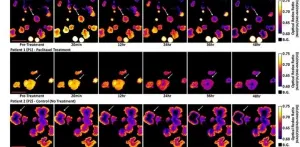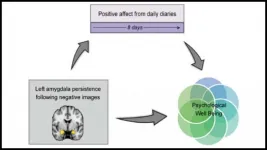Much is unknown about what causes these symptoms and how long they last. But with nearly 740,000 cases of COVID reported in New York City since last March--and 28 million in the United States--physicians are increasingly seeing these "long-haulers" in their practices.
"Over the course of the summer, we started getting a sense of what issues these people were having," says Ani Nalbandian, MD, a cardiology fellow at Columbia University Vagelos College of Physicians and Surgeons and first author of a new review of post-acute COVID-19.
"We felt that a review of all these possible issues would be important not only for health care providers but also for patients. It's important for patients to know that what they're experiencing may be a consequence of COVID-19 infection and that they are not alone in experiencing lingering effects of COVID-19 infection."
Nalbandian, along with co-first author Kartik Sehgal, MD, medical oncologist at Harvard Medical School and Dana Farber Cancer Institute, spearheaded the review effort, bringing together more than 30 experts from Columbia and other medical centers hit by the initial wave. The review summarizes what the physicians were seeing in their own patients and what others had reported in the literature. The experts represented a wide range of fields, including neurology, cardiology, and nephrology.
Nalbandian and Elaine Y. Wan, MD, the Esther Aboodi Assistant Professor of Medicine in Cardiology and Cardiac Electrophysiology at Columbia University, the review's senior author, discuss the symptoms that patients and providers should know about COVID-19 long haulers.
It's Not Just "Brain Fog"
Chest pain has been reported in up to 20% of COVID-19 survivors two months after recovery from the infection, COVID-19 can unveil previously unrecognized cases of diabetes, and a few percentage of patients experience strokes, pulmonary embolisms, and other complications from blood clots.
Wan's speciality is electrophysiology, and during the pandemic she and her colleagues published more than 10 articles about COVID and heart arrhythmias.
"Arrhythmias can lead to stroke, heart failure, and long-lasting damage to the heart," says, "and that's something that patients may not be aware of."
In addition, multiple organs may be affected simultaneously. "If you go to a cardiologist, the cardiologist may just focus on the heart," Nalbandian says. "But we need to think of the whole person since COVID is potentially affecting many organs, especially in those who have been hospitalized."
Everyone Is Vulnerable
Most people who experience long-term symptoms may have had health issues before contracting the virus or they developed very severe illness during COVID-19 infection.
"But really, any of these issues can happen to any patient who had COVID-19," says Wan. "For example, we've seen young patients without prior medical illness who developed autonomic dysfunction and fast heart rates after COVID-19. It's not just the most vulnerable who have issues after COVID."
"There really is a post-COVID syndrome and it doesn't always correlate with the severity of the acute COVID infection itself," says Nalbandian.
The majority of COVID patients never come to the hospital for treatment. "We may not be checking in on these patients with the same urgency, but they shouldn't be forgotten," she adds.
Symptoms Can Appear Weeks, Months after Recovery
"I have seen young patients, weeks even months after COVID-19 infection, and they've suddenly developed new onset of heart racing, palpitations, and chronic fatigue," says Wan.
Other patients complain weeks later of new chest discomfort or difficulty with decision making, memory, and concentration.
"When we think of COVID-19, we think of mostly a respiratory illness," Wan says. "But even after they've recovered from their respiratory illness, they may still have other clinical symptoms due to issues with other organ systems."
Patients Need Dedicated "COVID-19 Clinics"
"COVID-19 is the first infectious disease that I've come across that has such an effect on a wide variety of organs," Wan says. "It's changed my clinical practice. No matter what the patient comes in for, I now ask if they ever had COVID-19 infection. It changes the possible range of diagnoses."
"Based on this review, all of us recognized that there needs to be interdisciplinary care to treat patients longitudinally," says Nalbandian. "Care for patients with COVID-19 should not conclude at the time of hospital discharge."
To provide interdisciplinary care, health care systems should establish dedicated "COVID-19 clinics," similar to those now found in Italy.
Nalbandian says setting up such clinics in the United States has been difficult since physicians are still busy taking care of new COVID patients as subsequent waves come in. "Clinics could prioritize follow-up care for those at high risk for post-acute COVID-19 and those with the highest burden of persistent symptoms."
Patients Should Be Vocal
Nalbandian says many patients have complained that their doctors don't recognize that their symptoms may be related to COVID, and that's one reason she and her co-authors organized the review. "Here in New York, we're seeing patients who have been struggling for weeks and months looking for doctors who are knowledgeable," Nalbandian says. "Physicians should be attentive, legitimize patient concerns, and thoroughly document the symptoms."
Patients should not be afraid to be vocal about their symptoms. "Get in touch with your doctors even if you're not sure if your symptoms are lingering from your COVID infection," she says. "The situation is still fluid and we're learning more every month."
Join Patient Advocacy Groups and Clinical Trials
The work of new patient advocacy groups has helped identify persistent symptoms and was instrumental in highlighting the persistence of symptoms among those who didn't require hospitalization.
"Active engagement with these groups is crucial," Nalbandian says, "along with participation in clinical trials for longitudinal assessment."
Though the medical community now has a better grasp of the constellation of the long-term symptoms that occur after COVID, "we don't know the duration and the long term complications," Nalbandian adds.
"In order to learn more, we need to refer patients to trials, and we've listed many active research studies in our review.
"Health care providers are still overburdened taking care of patients with acute COVID, but that's a collective responsibility of the medical community at large."
INFORMATION:
Columbia University Irving Medical Center provides international leadership in basic, preclinical, and clinical research; medical and health sciences education; and patient care. The medical center trains future leaders and includes the dedicated work of many physicians, scientists, public health professionals, dentists, and nurses at the Vagelos College of Physicians and Surgeons, the Mailman School of Public Health, the College of Dental Medicine, the School of Nursing, the biomedical departments of the Graduate School of Arts and Sciences, and allied research centers and institutions. Columbia University Irving Medical Center is home to the largest medical research enterprise in New York City and State and one of the largest faculty medical practices in the Northeast. For more information, visit cuimc.columbia.edu or columbiadoctors.org.



